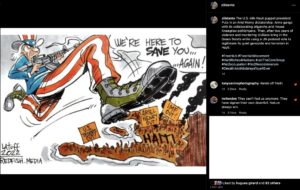English translation by Doumafis Lafontan
*
(Editor’s Note: Scroll down for the French original of this article. English translation by Doumafis Lafontan for HLLN, May 1, 2012.
The article outlines the similarities between SHADA (Haitian-American Society for Agricultural Development) clear-cutting, stripping fertile Haiti forests and lands to plant rubber and sisal for US market , creating hunger, destroying peasantry, their farms and Haiti’s ecosystem during the first US occupation with today’s second US occupation and Bill Clinton(UN)/Obama administration’s Caracol development in the North of Haiti. In the new book SHADA: Chronicle of an extravagant scam, Haiti scholar, Professor Myrtha Gilbert details US destruction of Haiti domestic agriculture, forest lands, peasantry wealth and ecosystem beginning with SHADA. See Ezili Dantò’s counter-colonial narrative on Haiti’s deforestation ; The Avatar Movie from a Black perspective by Ezili Dantò and Article on Majesco Haiti mining proves a point only Ezili’s HLLN has made. Since before the fall of the US-supported Duvalier dictatorships in 1986, the US has been bringing “hope” to Haiti. The newest, profit-over-people sweatshop hoax is Caracol, a sweatshop project masking the foreign appropriation of fertile Haiti lands and deep water ports. The Caracol sweatshop strategy “has absolutely nothing to do with creating a sustainable growth economy in Haiti.”)
********
Haiti / USA: The story of Shada, a reflection of an immediate reality of dependence
By Karenina Francesca Théosmy for AlterPress
April 27, 2012, Source: AlterPresse
English translation by Doumafis Lafontan for HLLN, May 1, 2012
P-au-Prince, April 27, 2012 [Source: AlterPresse] — “Shada, chronicle of an extravagant scam” is the title of the new book by Myrtha Gilbert, a university professor and researcher, who tries to breakthrough to the roots of poverty and economic dependence in Haiti.

In this book, Myrtha Gilbert unearths Shada, the specter of American domination, “a project that has left our agriculture in tatters, created extraordinary problems and issues that we feel even now,” she explains in an interview to AlterPresse.
The Haitian-American Society for Agricultural Development (Shada), was organized on July 30, 1941 under the government of Elie Lescot.
“I was still a little girl at the time, but the idea of destroying the plantations of food to replace them with rubber made me sad,” says Gilbert Myrtha.
Ezili Dantò’s counter-colonial narrative on Haiti’s deforestation“It’s a process that started in colonial times, continued under the 19-year US occupation (1915-1934) and now, it’s Haiti’s mountains that are being dug up, mined and destroyed by the International companies taking the mineral wealth of Haiti that are in the mountain rocks (gold, copper, uranium, iridium, granite, marble, coal and oil explorations) behind these UN guns.” See also,The Avatar Movie from a Black perspective ; HLLN on the causes of Haiti deforestation and poverty; Article on Majesco Haiti mining proves a point only Ezili’s HLLN has mad and Transcript – Haiti’s Riches: 2009 Interview with Ezili Dantò on Mining in Haiti by Chris Scott for CKUT -Audio 34:03- Ezili Dantò, HLLN. The secret behind the Rush to Haiti, 2009 interview
Since before the fall of the US-supported Duvalier dictatorships in 1986, the US has been bringing “hope” to Haiti. The newest, profit-over-people sweatshop hoax isCaracol, a sweatshop project masking the foreign appropriation of fertile Haiti lands and deep water ports. |
Years later, this slice of history challenged her with greater force because the same mechanisms are being put back in place. Particularly unbearable is the ignorance of Haitians of the harsh consequences of Shada.
Shada: hidden crime
Professor Myrtha Gilbert thoroughly searched the media archives — newspapers of the time, some from the provinces, others daily papers such as Le Nouvelliste, Le Martin — delved into the works written by Haitians and foreigners to reveal and expose this company with the stated purpose of “agricultural development”.
Long before the establishment of Shada in 1941, U.S. experts came at the beginning of the American occupation (1915-1934) of Haiti, to explore opportunities for “doing business in Haiti” recounts the book, “Shada, chronicle of an extravagant scam”.
Beginning in this period, they concluded that the island is one of the most appropriate in the Caribbean for the cultivation of rubber.
How surprising, says Gilbert!
Given the size of the United States of America compared to that of Haiti (300 times in size), the North American giant obviously has more land to grow rubber.
Nonetheless, the Shada company managed to establish itself, fundamentally in the Grande Anse (Southwest Haiti), not hiding, at any time, its interest in the most fertile lands to plant their rubber.
Gilbert shows how the Lescot government fulfilled the requirements of the occupiers to take fertile Haiti lands with frightening zeal: expropriating peasant lands against the backdrop of the anti-superstition campaign (against Vodou), destroying agricultural plantations, clear-cutting and destroying the forest under the guise of “scientific use”.
Within three years, the Shada company would uniformly perform a monstrous feat, causing, for example, the displacement of 250,000 people and clear-cutting a million fruit trees and 200, 000 pine trees in the mountains of Haiti.
About 70 years later, the Caribbean country has no more than 1% of its forest cover.
In “Shada, chronicle of an extravagant scam” Myrtha Gilbert follows this evil process, revealing the complicity of Haitian political leaders or their lack of policy.
There existed a perverse relationship between the international powers and certain local puppets to sell-off and irreparably harm the economy and future of Haiti, notes the researcher.
While working on the story of Shada, Professor Gilbert especially wished to highlight the root cause of Haiti’s food and economic dependence, clearly discernible today (in 2012), and as “cleverly thought out and established by the States United States of America, ” she maintains.
Bound hands and stomach
She explains the two opposing interests in this way: “The Haitian peasantry’s focus is to cultivate the land for food consumption while bartering its excess crops in trade for the manufacturing products needed. While the other vision is, ‘I do not care if you need to eat, because for me, I need rubber, henequén/sisal and other things. This is what you will produce on your land, even if it is your most fertile lands and the people starve'”.
The Henequen or Sisal plant
Industrial use of henequén/sisal, called pite in Haiti: Pite fiber makes ropes, cables, nets, lassos, curtains, hammocks, and other dense fabrics. Sisal blended with polyethylene makes light durable materials for toys, doors, boats, planes and even parts of tanks for the then US war effort. Under Lescot, the food needs of Haitians were of no consequence to the World War II profiteers from the US imperial corporatocracy just as it is of no consequence under Michel Martelly administration overseer to the Obama/Clintons (UN/USAID) coporatocracy in 2012 destroying Haiti’s fertile lands in the North with Caracol supposed assembly plans and big-business Caracol deep water ports. Article on Majesco Haiti mining proves a point only Ezili’s HLLN has made) Example of Henequen Products |
From the outset, the president of Shada, an American named Thomas Fennell, announced the policy of the United States of America to export to Haiti “lots and lots of food … and this is why we must be vigilant, “says Gilbert Myrtha.
For her, it is the starting point, especially for the decline of certain Haiti food products like the national rice (which culminated in the US subsidized agri-business dumping, since the 1986 – invasion on Haiti domestic market with imported US rice.)
The researcher cannot, at the same time, help make a connection between the statements of Paul Collier and the prospects of new implementation of free trade zones in the country.
The industrial park of Caracol, located on highly fertile land, is, in her view, a version of Shada.
“Similarly, one of the impacts of the Shada project was the great famine it brought into the country … and we can say that the vestiges of these plantation [rubber] still reverberate. One of the consequences is that Shada destroyed the country’s preoccupation with being sovereign and self-sufficient in its food production through its own domestic agricultural, a feat that even the American occupation had failed to achieve”.
In 2012, the government estimates that 4 million people are food insecure.
Despite the promising forecasts predicted by the National Coordination for Food Security (CNSA), some departments are still very vulnerable.
Meanwhile, the ruling team led by Joseph Martelly maintains its commitment to “open Haiti for business” and create jobs, which will pass, it seems, by the installation of industrial parks such as Caracol.
“This is how they want us to be. A country with ¾ of the population in the factories, to work as slaves. Because the destiny, which they want to submit us to is that of slavery,” underlines Myrtha Gilbert.
The consequences are easy to guess: “300 millionaires, 350,000 people in the slums, like Cite Soleil (the large agglomeration populist area north of Port-au-Prince) and 750 thousand boat people … Those who have privileges are blind and they do not see that one is playing with the fate of a country,” details the researcher.
“One must say enough! This is what already happened a few years ago. One cannot just continue to cripple the country this way!” She exclaims.
The bitter irony is that in “Shada, chronicle of an extravagant scam” Myrtha Gilbert tells us that Thomas Fennell, the president of Shada, was decorated by Elie Lescot and awarded for “Honor and Merit” for his “services to Haiti” in 1944, the year of the most dizzying operations of the company.
****************
FRENCH ORIGINAL
Haïti / Ãtats-Unis: L”histoire de Shada, reflet d”une réalité immédiate de dépendance
vendredi 27 avril 2012, Source: AlterPresse (See also, Ezili Dantò’s counter-colonial narrative on Haiti’s deforestation ; The Avatar Movie from a Black perspective by Ezili Dantò and Article on Majesco Haiti mining proves a point only Ezili’s HLLN has mad .)
*

Au moment où les autorités économiques vantent les «vertus» de l”implantation de la zone franche de Caracol (Nord-Est d”Haïti, après celle de Maribaroux / Ouanaminthe en 2003), malgré le risque de destruction de 40% des reserves en mangroves du pays, la publication de «Shada, chronique d”une extravagante escroquerie», interpelle sur l”histoire d”une expérience de plantation qui a contribué à renforcer la dépendance économique du pays…
Ezili Dantò’s counter-colonial narrative on Haiti’s deforestation “It’s a process that started in colonial times, continued under the 19-year US occupation (1915-1934) and now, it’s Haiti’s mountains that are being dug up, mined and destroyed by the International companies taking the mineral wealth of Haiti that are in the mountain rocks (gold, copper, uranium, iridium, granite, marble, coal and oil explorations) behind these UN guns.” See also, The Avatar Movie from a Black perspective ; HLLN on the causes of Haiti deforestation and poverty; Article on Majesco Haiti mining proves a point only Ezili’s HLLN has mad and Transcript – Haiti’s Riches: 2009 Interview with Ezili Dantò on Mining in Haiti by Chris Scott for CKUT -Audio 34:03- Ezili Dantò, HLLN. The secret behind the Rush to Haiti, 2009 interview
|
«Il faut dire assez, parce que voici ce qui s”est passé il y a quelques années. On ne saurait continuer ainsi à handicaper un pays»!
Par Karenine Francesca Théosmy
P-au-P, 27 avril 2012 [AlterPresse] — «Shada, chronique d”une extravagante escroquerie», c”est le titre du nouvel ouvrage de la professeure d”université et chercheure, Myrtha Gilbert, qui tente de faire une percée vers les racines de la misère et la dépendance économique d”Haïti.
Dans ce livre, Myrtha Gilbert exhume Shada, spectre de la domination américaine, «un projet qui a laissé notre agriculture en lambeaux, créé des problèmes extraordinaires et des problèmes que l”on ressent encore actuellement», explique t-elle dans une interview accordée à AlterPresse.
La société haïtiano-américaine de développement agricole (Shada), prend naissance le 30 juillet 1941 sous le gouvernement d”Elie Lescot.
«J”étais encore une petite fille à l”époque, mais l”idée de détruire des plantations de nourriture pour les remplacer par du caoutchouc m”avait rendue triste», raconte Myrtha Gilbert.
Des années plus tard, cette tranche d”histoire l”interpelle avec davantage de force, parce que notamment les conséquences de Shada sont crues et l”ignorance des Haïtiennes et Haïtiens, insupportable, alors que les m êmes mécanismes se remettent en place.
Shada: crime occulté
Journaux de l”époque, certains de province, quotidiens de référence (tels le Nouvelliste, le Matin)..: Myrtha Gilbert épluche la presse, fouille dans les ouvrages écrits par des Haïtiens et des étrangers, pour faire taire le silence sur cette compagnie à vocation de «développement agricole».
Bien avant l”implantation de Shada en 1941, des experts étasuniens sont venus, au début de l”occupation américaine (1915-1934), étudier des possibilités de «faire des affaires en Haïti», relate l”ouvrage «Shada, chronique d”une extravagante escroquerie».
Dès cette période, ils concluent que l”île est l”une des plus appropriées, dans les Caraïbes, à la culture du caoutchouc.
Ãtonnant, estime Gilbert!
Vu la taille des Ãtats-Unis d”Amérique par rapport à Haïti (300 fois en superficie), le géant nord-américain a, de toute évidence, plus de terres pour cultiver le caoutchouc.
Cependant, la compagnie Shada parvient à s”installer, fondamentalement dans la Grande Anse (Sud-Ouest), ne cachant, à aucun moment, son intér êt envers les terres les plus fertiles pour planter son caoutchouc.
Cette exigence sera satisfaite par le gouvernement de Lescot avec un zèle effarant: expropriation des paysans sur fond de campagne anti-superstitieuse (contre le vodou), destruction de plantations agricoles, déboisement et destruction de for êts sous couvert «d”exploitation scientifique», montre Gilbert.
En l”espace de trois ans, la compagnie Shada accomplit un monstrueux exploit, en provoquant, par exemple, le déplacement de 250 mille personnes ainsi que la coupe d”un million d”arbres fruitiers et de 200 mille pins dans les montagnes d”Haïti.
Environ 70 ans plus tard, le pays caribéen n”a pas plus de 1% de sa couverture forestière.
Dans «Shada, chronique d”une extravagante escroquerie», Myrtha Gilbert suit ce processus aux allures diaboliques, dévoile la politique des dirigeants haïtiens ou leur absence de politique.
Il existe une relation perverse entre les puissances internationales et certains nationaux pour instaurer des mécanismes néfastes pour l”économie et l”avenir du pays, relève la chercheure.
En travaillant sur l”histoire de Shada, la professeure Gilbert souhaite surtout mettre en lumière les rouages et les racines de la dépendance alimentaire et économique d”Haïti, bien perceptible aujourd”hui (en 2012), «habilement pensée et instaurée par les Ãtats-Unis d”Amérique», révèle t-elle.
Ventre et poings liés
«Parce que, la vision de la paysannerie haïtienne, c”est de cultiver la terre et d”échanger ses produits contre ceux dont elle a besoin par le commerce, alors que l”autre vision, c”est ”je me fiche que tu aies besoin de manger, parce que, moi, j”ai besoin de caoutchouc, de pite et d”autres choses. Et, c”est ce que tu vas produire sur tes terres”, m ême si ce sont les plus fertiles et que la population meure de faim», explique t-elle.
Dès le départ, le président de Shada, un américain du nom de Thomas Fennell, a annoncé la politique des Ãtats-Unis d”Amérique d”exporter vers Haïti «beaucoup, beaucoup de produits alimentaires”¦ Et c”est pour cela que nous devons être vigilants», rappelle Myrtha Gilbert.
Pour elle, c”est le point de départ, notamment, du recul de certains produits à l”image du riz national (depuis 1986 avec l”ouverture – invasion du marché national par le riz importé)
La chercheure ne peut pas, dans le m ême temps, s”emp êcher de faire un lien avec les déclarations de Paul Collier et l”implantation de zones franches dans le pays.
Le parc industriel de Caracol, installé sur des terres hautement fertiles, constitue, Ã ses yeux, une version de Shada.
«Justement un des impacts du projet de Shada, c”est la grande famine qui existait dans le pays”¦et on peut dire que, jusqu”à présent, il existe des vestiges de ces plantations [de caoutchouc]. Et l”une des conséquences, c”est que Shada a dévié le pays de la vocation d”avoir une autosuffisance alimentaire grâce à son agriculture, vocation que m ême l”occupation américaine n”avait pas réussi à pervertir».
En 2012, les autorités estiment que 4 millions de personnes sont en situation d”insécurité alimentaire.
Malgré de bonnes perspectives, prédites par la coordination nationale pour la sécurité alimentaire (Cnsa), certains départements demeurent très vulnérables.
Entre-temps, l”équipe au pouvoir, dirigée par Joseph Michel Martelly maintient sa volonté d” «ouvrir Haïti aux affaires» et de créer des emplois, volonté qui passe, semble t-il, par l”installation de parcs industriels comme Caracol.
«C”est ainsi qu”ils nous veulent. Un pays avec ¾ de la population dans les usines, à travailler comme des esclaves. Parce que le destin, auquel ils veulent nous soumettre, est celui de l”esclavage», souligne Myrtha Gilbert.
Les conséquences sont faciles à deviner: «300 millionnaires, 350 mille personnes dans les bidonvilles, comme Cité Soleil (grande agglomeration populaire au nord de Port-au-Prince)et 750 mille boat people”¦ Celles et ceux qui ont des privilèges sont aveugles, elles et ils ne voient pas qu”on est en train de jouer avec le destin d”un pays», illustre la chercheure.
«Il faut dire assez, parce que voici ce qui s”est passé il y a quelques années. On ne saurait continuer ainsi à handicaper un pays!», s”exclame t-elle.
Cerise sur gâteau, «Shada, chronique d”une extravagante escroquerie» de Myrtha Gilbert nous apprend que Thomas Fennell, président de la Shada, a été décoré par Elie Lescot de l”ordre «Honneur et Mérite» pour «services rendus à Haïti», en 1944, année bouclant les opérations de la compagnie. [kft rc apr 27/04/2012 0:40]
****************************************
Recommended HLLN Links:
Article on Majesco Haiti mining proves a point only Ezili’s HLLN has made
“The white saviors and corporate media have ignored HLLN’s points made about Haiti riches for 8-years, summarily ignoring the Haiti grassroots concerns about the economic reasons for the 2004 Bush Regime change. To acknowledge Haiti riches available to be used to elevate the people from containment in poverty would not promote their poverty pimping and colonial narrative for “saving”
poor-and-without-resources-Haiti.
In particular, HLLN has been the only human rights and public advocacy
organization to warn of the one-percenters’ desire to take Caracol, Fort Liberte and other Northern Haiti ports, Islands and Northern riches. All, in complicity
with the UN, Haiti technocrats from abroad, Duvalierist puppets and the local
oligarchs. The US occupation behind the NGO invasion and UN military. allows the likes of Bill Clinton, George Bush and their global partners to carry forth
with the old US notion of building oil refineries and use of Fort Liberte as a
transshipment terminal for US supertankers. (See, Article on Majesco Haiti mining proves a point only Ezili’s HLLN has made and Majescor mining flourishes in post-quake Haiti .)
Ezili’s HLLN on the Counter-Colonial Narrative on Deforestation
The Avatar Movie from a Black perspective
**
As a result of these US unfair trade policies, Haiti lost over 830,000 rural Haitian jobs and hundreds of thousands of Haitians were forced into the capital looking for work, where eventually they would meet up with the massive earthquake and death on January 12, 2010 at 4:53. Today the Clintons, Obama and Cheryl Mills want Haitians to be grateful for PROMISES of future 20,000 sweatshop jobs built on fertile land that displaced more small farmers.
Years from now, when the gold/copper/iridium/and oil-rich North of Haiti is a slum & a crater, the U.S. will apologize as Bill Clinton did for destroying #Haiti food sovereignty
– ( Bill Clinton’s Heavy Hand on Haiti’s Vulnerable Agricultural Economy)
Read Corruption Uninterrupted http://bit.ly/HbrRW3 and Dady Chery’s detailed coverage on Caracol at:
Fertile Land Seized for New Sweatshop Zone
http://bit.ly/IDLLp1
Caracol Free-Trade Zone Jeopardizes Natural and Cultural Heritage
http://bit.ly/H2JS7u
Caracol #Haiti Industrial Park With Projected Adverse Environmental Impact
http://bit.ly/xzr97A
Industrial Park Threatens Precious Caracol Bay Ecosystem
http://bit.ly/ynSuQt
Poison Seeds, Herbicides, Pushed Again on Haitian Farmers in Spring 2012
http://bit.ly/HbH9HW
The Island of Haiti is almost a billion years older than previously believed
http://bit.ly/pphCtM
Grotte Marie-jeanne de Port-a-piment – The biggest caves in the Caribbean are
in #Haiti. Did you know that?
Haiti possesses the largest and richest heritage of cave art in the Caribbean,
and probably the most important collection in the Americas.
Video interviews- Ezili Dantò grassroots Haiti news on Radio Rezistans (The
Maroon Voice) Part 1 http://bit.ly/bYjmjm ; Part 2 http://bit.ly/Ine5Qo ; Part
3 http://bit.ly/ItfuoL and Part 4 – http://bit.ly/IVbyv9
***********************
In Haiti, industrial park fuels hope and anxiety
Jacqueline Charles | McClatchy Newspapers | Source: Miami Herald, June 6, 2012
CARACOL, Haiti — Braving the heat, Fanilia Prospere took a break from pushing her wheelbarrow of imported used clothing to look around. Then she smiled.
In Haiti, where so many promises of change turn to dust, the evolving landscape was worth the moment of contemplation: warehouse-sized factory shells rising from fertile soil, bulldozers rumbling distantly as they cleared farmland to build hundreds of homes and unemployed young men chattering under a mango tree about the change that was coming to Caracol.
“Caracol is getting another image,” said Prospere, 30, a mother of three. “There are a lot of people who weren’t working, but they are now working. And a lot of people who want to work and who I believe will be soon working.”
For the bucolic but impoverished fishing village on Haiti’s northern coast, the sight of foreign dollars creating new housing and jobs is filled with hope – and worry that the multimillion-dollar investments also will spawn the all-too-familiar slums.
“It is almost certain,” said Jilson St. Tilien, as he watched a game of dominoes under the tree. “People need to make a living and they will move here to do so.”
Desperate for any good news after the devastating January 2010 earthquake, the Haitian government signed off on the 600-acre industrial park in this remote rural village without preparing for how the region should eventually look – or absorb the promised jobs. Only now is a zoning plan being developed, but residents and Haiti watchers wonder if it’s coming too late.
Their anxiety is fueled by Haiti’s historically weak institutions and the rush by the international community and Haiti’s leaders to show progress. It is also a reflection of the challenges of working in Haiti where there is continuous friction between need-to-spend foreign aid agencies, which are often perceived as arrogant, and a weak central government.
As a result, Haiti analysts say, projects are often haphazardly started with too little preliminary planning, lopsided consultation and inadequate environmental impact studies.
“The international community has been under immense pressure to show movement and this is the closest they’ve come to have something significantly positive to say about Haiti, investments and jobs,” said Carlo Dade, a senior fellow at the University of Ottawa’s School of International Development and Global Studies. “But on the other hand, this is really one case where there is no excuse for not getting it done right.”
From the start, U.S. and Haitian officials have heaped billboards of praise on the $300 million investment. But it quickly became a target of criticism.
While supporters tout the park and its amenities as a steel and concrete example of rebuilding Haiti after the quake, agriculturalists and environmentalists criticized its location on prime arable land at the mouth of an already endangered marine and mangrove-forest ecosystem.
Others worry that while the park’s job-creation benefits may help to depopulate Haiti’s teeming capital city 82 miles away, it risks replicating the very social and political ills that have plagued sprawling slums like Cite Soleil.
“When you look at the social problems that Cite Soleil poses today, you have to ask, did it have to be that way?” said Michele Oriol, executive secretary of Haiti’s Inter-ministerial Commission on Territorial Planning, which has objected to the park’s location, and that of a U.S.-financed housing development just off the main commercial corridor.
“The North-Northeast region is today enjoying a concentration of investments. That is a big deal in Haiti,” she said. “But there is a price to be paid. There are a series of measures that need to be taken.”
The U.S. government and Inter-American Development Bank, which are jointly funding the industrial park’s development, say while it is the most visible symbol of post-quake progress, it is only part of the investment that donors are pouring into the northern corridor to spur economic growth. About $1 billion is being invested in agriculture, electricity, health, housing, roads and schools.
“We heard the government after the earthquake when they said, ‘We want to create other regions where people have reasons to stay, and livelihoods that they can pursue.’ Our investments in the north were designed to meet that goal,” said Cheryl Mills, counselor and chief of staff for U.S. Secretary of State Hillary Clinton, who has held town hall meetings in Haiti about the park. “This is really for us an opportunity to bring the one thing that people have said most intensively that they need and want. They want jobs.”
Scholar Alex Dupuy, who has written extensively about the failures of Haiti’s cut-and-sew economy, says while the current push to revive Haiti’s garment assembly industry may come with what he calls “side benefits” – roads, port upgrades and a new $45 million power plant, to name a few – the strategy ” has absolutely nothing to do with creating a sustainable growth economy in Haiti.”
“It’s about tapping a source of cheap labor,” said Dupuy, a Haiti-born sociology professor at Wesleyan University in Connecticut. “They did the same thing in Port-au-Prince, which had people leaving the countryside because of the free-trade policies that have devastated the Haitian agriculture sector. So the fear that the region will be flooded is very real.”
Late last year, President Michel Martelly, who inherited the project from the previous administration, agreed to ask the American Institute of Architects to work with the eight local communities affected by the planned development to create a regional master plan.
The plan takes into account not just the park and its 65,000 projected jobs but 5,000 proposed USAID and IDB-financed homes for the corridor; a recently built private high school; and yet-to-open Dominican Republic-financed university in the nearby town of Limonade.
Also part of the mix is the potential impact of U.S.-financed regional hospitals’ upgrades, construction of roads and a new seaport in nearby Fort Liberte. A planned Venezuela-financed upgrade to the Cap-Haitien airport is also being considered.
Erica Gees, executive director of AIA’s nonprofit arm, said up to 35 planners and designers have been working on the regional plan, which will need to be adopted by all affected communities. Among the recommendations that will be presented in late June, Gees said, will be infrastructure upgrades in existing communities to absorb the growth. The park is expected to attract up to 300,000 new residents, or five people for every one worker hired. With town populations currently ranging between 1,500 and 25,000 residents, Gees said, residents’ fears are real and legitimate.
“You have a very solid existing social structure. People know each other; they have been farming the same land for generations. There is a real sense of security,” she said. “You want to enhance that by integrating newcomers into each town in a more organic process. By combining urban upgrades and expansion with strategic placement of services and public space, you can ease the impact of rapid growth.”
Oriol’s agency had made similar recommendations in order to help reduce possible conflict with residents and prevent the main commercial corridor from being blocked should unrest occur. Her group was asked by former Prime Minister Garry Conille to intervene after regional parliamentarians, complaining they had been left out of the loop amid meetings between U.S. officials and local mayors, objected to the location and size of the U.S.-planned houses near the main access road.
Conille put the housing on a permanent hold, but Martelly, who didn’t want to delay the housing construction, overruled him.
The U.S. has since modified the housing scheme, increasing the sizes of the houses slightly and pushed the development further off of the street to allow for future expansion of the road. But lawmakers like Pierrogene Davilmar remain unhappy.
“We know the country,” he said, adding that the current location will still wreak havoc and the overall project has been too piecemeal.
One thing that has been well-planned is the engineering of the actual industrial park on former farmland.
Last month, as the first four hurricane and seismic-resistant buildings were completed, hundreds of Haitians were inside laying electricity cables, unpacking boxes and assembling chairs and work stations. All four buildings belong to Korean garment manufacturer Sae-A, a major supplier of U.S. retailers. As the park’s anchor tenant, Sae-A will create 20,000 jobs over four years, and occupy 23 custom buildings, including 12 factories of 120,000 square feet each.
Value of Sae-A’s Haiti investment: $74 million.
Among the park’s highlights: the best drainage system in Haiti with man-made lagoons to control flooding; landscaping and paved roads; a police station, clinic, customs office and power station with fossil fuel and solar power; a 46-room wired executive hotel with another one being planned; and a $14 million water treatment facility. Sae-A plans to open Haiti’s first textile fabric mill, which has raised concerns among environmentalists. They point out that an IDB consultant’s report noted there wasn’t enough time to evaluate the potential impact of the garment dyeing on the nearby ecosystem. U.S. officials say the park will meet international standards, and the treated water will be cleaner than the soiled water currently flowing into a nearby river.
“No matter the drawbacks, Caracol, however you look at it, is more than a positive step,” said businessman Rudolph Boulos, a former senator for the northeast region.
Still, residents have mixed feelings about the coming transformation of this historical region, which gave birth to the country.
“When you aren’t working, you have no other choice but to take what you can,” said Estefan Paul, taking a break from his $5-a-day manual labor job inside one of the new factories.
“The local authorities, they don’t speak up for you. Whatever the foreigners say they are going to do, they accept.”
Haiti Commerce Minister Wilson Laleau said he understands the concerns. But Haiti, he said, has to start somewhere to create jobs.
“The industrial park is not a solution that will resolve all of the problems,” he said. “But it is one of the mechanisms that will help us to find a solution to have money circulated in the region, and that will allow for other activities like tourism and agriculture to develop so that we can develop a middle class. A lot of countries have taken this route.”
Add a comment:
Powered by Facebook Comments









